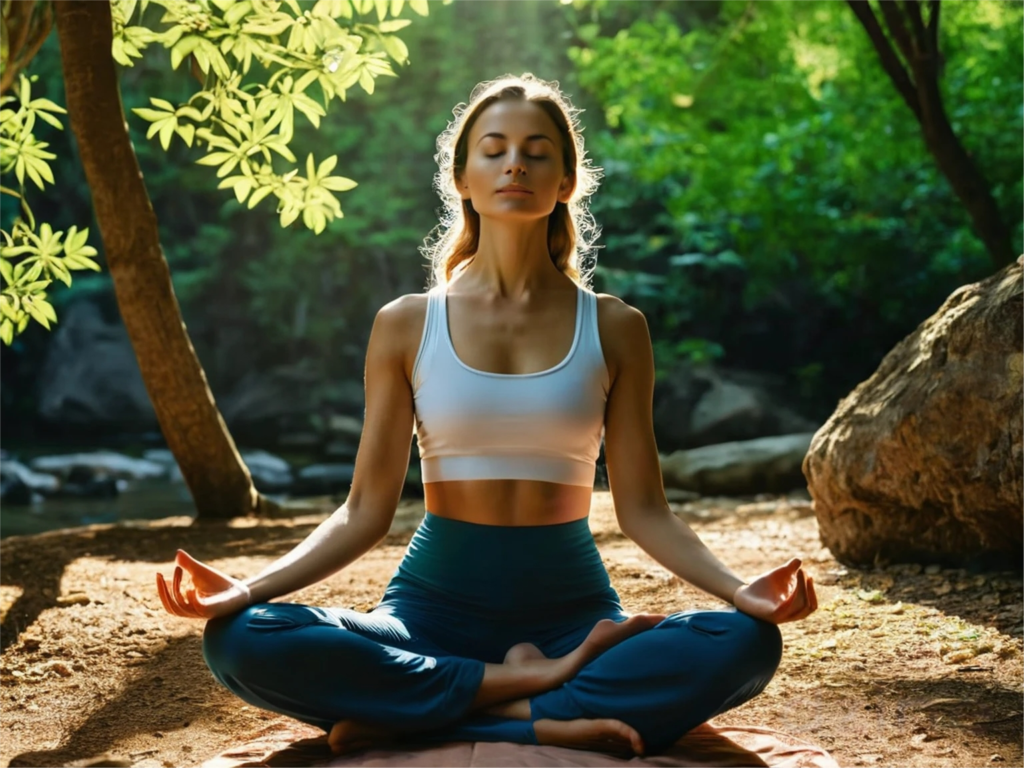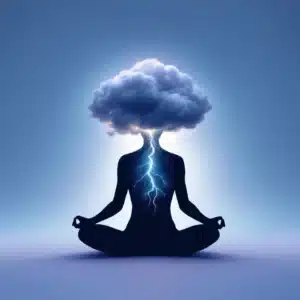Beginner’s Guide to Meditation: Find Your Inner Calm

In today’s fast-paced world, finding inner peace is more important than ever. Life’s demands and stresses can be overwhelming. But, have you ever wished for a break, a way to calm down and focus on the now? Meditation could be the answer you’ve been looking for.
Meditation is more than just a spiritual activity. It’s a powerful way to grow personally, reduce stress, and improve your well-being. If you want to quiet your mind, enhance your focus, or just find peace, this guide will show you how to start meditating. You’ll learn the basics to begin your meditation journey and experience its life-changing benefits.

Key Takeaways
- Meditation can help reduce stress, improve focus, and cultivate inner peace.
- Beginners can start with short, 5-10 minute sessions and gradually increase the duration over time.
- Consistent daily practice is more effective than sporadic longer sessions.
- Guided meditations and mantras can be helpful tools to enhance focus and relaxation.
- Integrating meditation into your daily routine, such as during morning, lunch, or evening, can help establish a sustainable practice.
What is Meditation?
Meditation is all about focusing your mind to reach a calm and clear state. It means being fully in the moment, watching your thoughts and feelings without judging them. By doing meditation often, you can see many benefits that make you feel better overall.
Understanding the Essence of Meditation
Meditation has been around for thousands of years, part of many spiritual and cultural traditions. Now, science is studying it more, using tools like EEG and fMRI to see how it changes the brain and helps mental health.
Benefits of a Regular Practice
Being regular with meditation brings many good things, like:
- Less anxiety, depression, and PTSD symptoms
- Better focus and thinking skills
- Improved emotional problem-solving
- Changes in the brain that help with senses, thinking, and feelings
- Keeping the brain healthy and slowing down age-related decline
- Feeling calmer, more positive, and relaxed
- Better sleep and stronger immune system
- More self-awareness and personal growth
- Stronger mental toughness and handling life’s ups and downs
- Improved relationships and talking with others
By setting aside time for meditation, you can gain many benefits for your body, mind, and heart. This can make your life better and more fulfilling.
“Meditation is the dissolution of thoughts in Eternal awareness or Pure consciousness.” – Swami Sivananda
Creating Your Sacred Space
Creating a dedicated meditation space in your home can deeply improve your practice. This space should be a quiet place where you can escape the world and focus inward. By choosing your surroundings carefully, you’ll make a space that helps you find yourself.
First, pick a quiet spot in your home that feels peaceful and welcoming. It could be a cozy corner in your bedroom, a quiet nook in your living room, or a special room if you have enough space. Once you’ve picked the spot, start adding things that make you feel calm and thoughtful.

- Incorporate soft, natural lighting such as string lights or small lamps to create a warm, soothing ambiance.
- Surround yourself with objects that hold personal meaning, like crystals, statues, or photos of your loved ones.
- Adorn your space with calming decor, such as plants, candles, or a meditation cushion.
- Use aromatherapy, such as incense or essential oils, to engage your sense of smell and promote relaxation.
| Recommended Items for Your Sacred Space | Percentage of Individuals Who Suggest Them |
|---|---|
| Incense or spiritual candles | 100% |
| Sage sprays | 100% |
| Stones and crystals | 100% |
| Cozy fabrics like blankets and pillows | 100% |
| Wooden boxes or stands to hold self-care items | 100% |
| Journal and morning reflection books | 100% |
| Oracle cards for spiritual guidance | Mentioned as a form of sacred divination |
| Subscription box for self-care items | 100% |
| Recommended gemstones for healing and introspection | Blue Calcite, Angelite, Citrine, Yellow Jasper, Carnelian, Sunstone |
The most important thing in making your sacred space is to make it your own. Try different things until you find what works best for you. This way, you’ll create a space that makes you feel grounded, centered, and ready for meditation.
Posture and Comfort for Meditation
Finding a comfy posture for meditation is key. You don’t have to sit cross-legged if it hurts. Try different positions to see what feels best for your body.
Seated Positions
Try out various seated meditation spots. You might sit on a cushion, a chair, or a bench. The main thing is to stay relaxed and focused.
Use props like blocks, books, or blankets to help your back or hips. This makes sure your spine is aligned and your body is at ease.
Lying Down Posture
If you like to relax more, lying down for meditation works well. Sit on your back with your legs out and arms by your sides. You might want a small pillow under your knees or head for extra comfort.
Try different lying meditation ways to find what lets you relax best and stay in the moment.
The aim is to find a meditation posture that feels right for you. Don’t hesitate to experiment until you find the one that brings you the most calm and focus.
The Breath: Your Anchor to the Present Moment
Meditation helps you focus on the now, and your breath is key. By noticing your meditation breathing, you stay in the moment. This reduces stress and makes you feel more connected to the world.
When you close your eyes and feel the air move in and out, your breath awareness keeps you grounded. It stops you from worrying about the past or future. This is the heart of mindfulness, which is great for your well-being.
No matter your experience with meditation, your breath always pulls you back to the present moment. If your mind drifts off, just focus on your breath again. Let it be your friend as you move through your meditation.
“The breath is the bridge between the body and the mind. By focusing on your breath, you can cultivate a deep sense of presence and connection with the here and now.”
Adding breath awareness to your day can also help you stay grounded. Just take a break, close your eyes, and feel your breath. This simple act can clear your mind, lower stress, and bring peace to your day.
Your breath is always there to bring you back to the now. Use it as a way to practice mindfulness. Let it lead you to a deeper understanding of yourself and the world.
Embracing Thoughts and Letting Go
As you start your meditation practice, you might see lots of meditation thoughts and feelings. It’s key to see these thoughts with non-judgment. Just watch the thoughts come and go, without sticking to them. Think of your thoughts as clouds moving across the sky – let them move on by without holding onto them.
By being mindful and present, you can easily bring your focus back to your breath focus. The breath helps you stay in the now and lets you let go of mind distractions. With time, you’ll get better at catching when your mind strays and smoothly come back to your breath.
Observing Without Judgment
Meditation teaches us to be non-judgmental. When thoughts pop up, don’t judge them. Just notice they’re there but don’t try to change or control them. Look at your thoughts with curiosity and kindness, letting them come and go without holding onto them.
Returning to the Breath
If your mind starts to wander, bring your focus back to your breath. The breath keeps you grounded in the now and helps you let go of distractions. Pay attention to the air moving in and out, or your belly rising and falling. With each breath out, let go of any tightness and relax into calm and mental clarity.
“When we let go of our battles and open our hearts to things as they are, then we come to rest in the present moment. And in that moment, we discover that which is greater than our worries, our fears, our anger, and our sadness.” – Pema Chödrön
By accepting your thoughts and feelings, and then letting go of them, you’ll grow in self-awareness and inner peace. Remember, meditation isn’t about getting rid of thoughts or feelings. It’s about watching them with mindfulness and answering with compassion. Trust the process, and enjoy the journey of finding yourself.
Guided Meditations and Mantras
If you find it hard to keep your focus on just your breath, guided meditations and mantras can help. These tools are great for your meditation practice. Guided meditations are like audio guides that give you instructions and gentle reminders. Mantras are words or phrases you repeat to yourself to keep your mind focused.
Mantra meditation is all about repeating a word or phrase to keep your mind in check. It’s perfect for those who struggle with staying focused at first. You can do it by yourself, silently, or even out loud. Some common mantras include “Om Mani Padme Hum,” “Om,” “So Hum,” and “Lokah samastah sukhino bhavantu.”
Guided meditations can help with stress and anxiety, or connect you with spiritual guides and loved ones in Spirit. The website offers a variety of guided meditations every week. You can find meditations for stress relief, heart healing, or just to help you focus.
Try out different guided meditation and mantra methods to see what works best for you. Whether you like following along with guided instructions or repeating a simple mantra, both can help you stay focused and mindful. They can also improve your overall well-being.
| Guided Meditation | Mantra Meditation |
|---|---|
| Addresses practical purposes like stress reduction and anxiety relief | Historically linked to spiritual traditions like Hinduism and Buddhism |
| Can focus on spiritual aspects like connecting with spirit guides and loved ones | Involves repeating a word or phrase to focus the mind and prevent wandering |
| Provides instructions and gentle reminders throughout the meditation | Can be practiced alone or by chanting mantras silently or aloud |
“Mantras are used for centuries to cultivate mindfulness, reduce stress, and enhance self-awareness.”
Start Small, Stay Consistent
Starting a meditation practice should begin with small steps. It’s more important to be consistent with short meditation sessions than to meditate for long periods without regularity. Regular, brief sessions can bring calm and clarity to your day.
Studies suggest that 10 minutes of meditation daily is better than one long session a week. Many find it hard to keep up with a meditation habit, starting strong but losing steam. Yet, tracking your progress can help you stay on track, as noted by Peter Drucker, “What gets measured gets improved.”
- Use visual aids like stickers or smiley faces on a calendar to monitor your meditation consistency.
- Explore different meditation techniques to find the one that resonates best with you, as not all methods suit everyone.
Begin with just 3-5 minutes of meditation each day. This small step builds confidence and shows that consistent meditation is possible. As you see the benefits, like less stress and better sleep, you’ll want to meditate more.
“The power of daily meditation is transformative. It has the potential to enhance our mental and emotional well-being in ways we never imagined.”
I started meditating two years ago and now meditate for 15 minutes daily. I’ve logged 2,800 minutes on the Insight Timer app. I invite you to try a 5-day meditation challenge with me, meditating for five minutes each day. See the benefits for yourself and make meditation a daily routine.
Integrating Meditation into Your Daily Routine
Creating a regular meditation routine unlocks its deep benefits. When you add meditation to your daily activities, it turns into a valued habit. This habit can change your life. The goal is to find the best time and make it a smooth part of your day.
Finding the Right Time
Try different times to see when meditation fits best for you. Some start their day with a few minutes of mindful practice. This sets a calm and clear tone for the day. Others like to meditate during their lunch break to refresh and recharge. For those who feel stressed before bed, an evening meditation session can help improve sleep quality. The key is to pick a time that fits naturally into your life.
Making it a Habit
- Being consistent is crucial for habit formation. Try to meditate at the same time every day, even if it’s just for a few minutes.
- Set up a special meditation space that’s quiet, comfy, and free from distractions. This helps your brain link that place with your daily practice.
- Use guided meditation apps or recordings to help you stay focused and relaxed, especially when you’re starting out.
- Don’t worry if you miss a day. Meditation is a skill that grows over time. Celebrate your progress and get back to it the next day.
By finding the right time and making meditation a regular part of your day, you’ll see its amazing benefits. It’s a journey of self-discovery and stress reduction. This journey brings more focus, clarity, and a deeper sense of well-being.
“The journey of a thousand miles begins with a single step.” – Lao Tzu
Celebrating Your Meditation Journey
Embrace the meditation progress you’ve made on your path to inner peace and personal growth. Each meditation session is a chance to grow your self-compassion and mindfulness. This journey is about self-discovery and change, not a race.
Some days, your mind may wander during meditation. That’s okay. Be kind to yourself and don’t judge yourself. Celebrate the small wins, like finding moments of calm, as you explore meditation’s deep benefits.
Embracing the Experience
On your meditation journey, take a moment to see how far you’ve come. Notice the improvements, like better focus, less stress, or more inner peace. Acknowledge the positive changes in your life.
- Reflect on your meditation progress and its impact on your well-being.
- Try different meditation techniques to keep it interesting.
- Join a meditation community for support and inspiration.
- Use mindfulness in daily life to stay present.
Your meditation journey is special to you. Embrace each moment, celebrate your wins, and ask for help when needed. With time and effort, you’ll keep discovering the power of meditation.
“Meditation is not a way of making your mind quiet. It’s a way of entering into the quiet that is already there – buried under the ‘noise’ of compulsive thinking.” – Deepak Chopra
| World Meditation Day | History | Benefits |
|---|---|---|
| Held annually on May 21 | Around since 1500 B.C. | Stress reduction, enhanced concentration, and physical health improvements |
| Provides a sense of unity and shared energy | Oldest known practice for inner exploration | Lowered blood pressure, reduced anxiety, and improved productivity |
Meditation Techniques for Beginners
Starting your meditation journey? Try the body scan and mindfulness meditation. These methods can lessen stress, boost self-awareness, and bring calm.
Body Scan
The body scan meditation means paying attention to your body, from head to toes. It helps release tension and boosts awareness. Sit or lie down comfortably, then focus on your toes, feet, legs, and so on. Notice any feelings without judging them.
Mindfulness Meditation
Mindfulness meditation helps you stay in the moment. You watch your thoughts, feelings, and body sensations without judgment. Start with your breath, then notice the world around you.
Try these meditation techniques and see what works for you. With regular practice, you’ll find stress reduction, better self-awareness, and peace.
| Meditation Technique | Description | Benefits |
|---|---|---|
| Body Scan | Systematically directing attention to different areas of the body, noticing sensations | Releases tension, increases body awareness |
| Mindfulness Meditation | Being fully present in the moment, observing thoughts and sensations non-judgmentally | Reduces stress, enhances self-awareness, promotes inner calm |
“Meditation is not about becoming a different person, a new person, or even a better person. It is about training in awareness and learning to be present.” – Jon Kabat-Zinn
Conclusion
Meditation is a powerful way to find peace and reduce stress. It also helps improve focus, self-awareness, and spiritual growth. By setting up a special space and trying different meditation methods, you can start a journey of self-discovery and peace.
Many studies show how meditation helps our health. It can ease stress, make us happier, and boost our thinking skills. If you want to handle anxiety, pay better attention, or understand yourself better, meditation can help.
Keep exploring meditation with kindness and an open mind. Stick with it and find what works best for you. This way, you’ll see how meditation can change your life for the better. It can help you take care of your mind, body, and spirit. Let meditation lead you to a life filled with calm, focus, and spiritual growth.
FAQ
What is meditation and how can it benefit me?
Meditation helps you focus and calm your mind. It makes you less stressed and anxious. It also improves your focus and self-awareness. Plus, it brings peace and emotional balance.
How do I create a comfortable and peaceful environment for meditation?
Choose a quiet spot in your home for meditation. It could be a corner of your bedroom or a cozy nook. Add things like candles, incense, or plants to make it peaceful.
What is the best posture for meditation?
Your meditation posture should be comfy. You don’t have to sit cross-legged. Try sitting on a cushion, a chair, or lying down to find what works for you. The goal is to relax and stay focused.
How do I use my breath as an anchor during meditation?
Use your breath to keep your focus. Close your eyes and feel the air move in and out. This helps you stay in the moment and reduces stress.
How do I handle thoughts and emotions that arise during meditation?
Notice your thoughts and feelings without judging them. Just acknowledge them and go back to your breath. Think of them as clouds passing by. This helps you stay present and aware.
What are some helpful tools for my meditation practice?
Guided meditations and mantras can help if focusing is hard. These are audio or apps that guide you. Or, you can repeat mantras to yourself. Try different things to see what works for you.
How do I build a consistent meditation practice?
Start small with meditation, just a few minutes a day. Then, slowly add more time. Being regular is key, not how long you meditate. Regular practice brings calm and clarity to your day.
What are some effective meditation techniques for beginners?
Try the body scan or mindfulness meditation if you’re new to it. The body scan focuses on your body’s sensations. Mindfulness is about being fully in the moment without judgment. See what works best for you as you meditate more.


